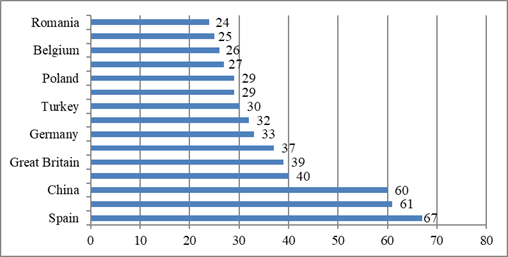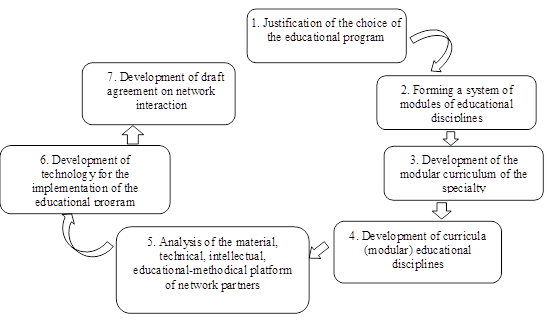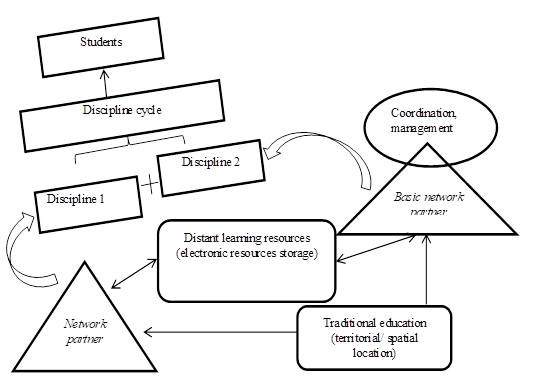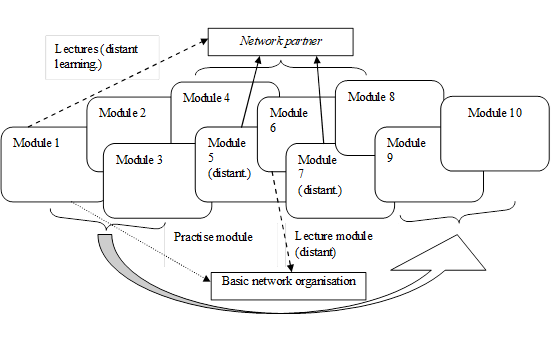Abstract
Networking between educational institutions is a mechanism for implementing joint resource potential. The authors presented an example of a step-by-step development of the curriculum for the educational program of the first stage of higher education on the basis of the formation of training modules and the use of distance learning technology. The proposed model of network interaction determines the growth of competitiveness of each network partner by offering each of them their advantages, mobilization of personnel, material, technical, educational, methodological, scientific potentials. A relatively new phenomenon for higher education institutions in the Republic of Belarus is the implementation of educational programs through a networked form of interaction. The reason is that the approaches are not developed, there are no clear regulatory and legal recommendations, there are no theoretical and methodological foundations and requirements for the organization of the educational process in a network form. The results of practical testing of these models will be given in subsequent studies. The presented model of phased implementation of network interaction positions a new approach to learning on the basis of alternative forms of implementing training modules. The educational environment, correlating with the dynamics of the labor market situation, the process of globalization and integration generate new forms, tools, training tools, making maximum use of their intellectual, material and technical, financial potential, carrying out systematic monitoring of needs, sustainability and shaping the learner's opinion on quality, training , which corresponds to the modern realities of the socio-economic system in the national and international format.
Keywords: Network interactioneducational programnetwork partnerbasic partnertraining moduledistance learning technologies
Introduction
The network form of the implementation of educational programs is the mastering of the educational program by the students using the resources of several educational institutions (organizations implementing educational programs of higher education) and other organizations, including foreign ones, which have the resources necessary to carry out the types of educational activities provided for by the relevant educational standards (Bugrii, 2007). The main goal of such interaction is the integration of educational, scientific, personnel, material and technical and innovative potential of educational institutions and organizations to improve the quality of training of modern specialists.
Problem Statement
The main goal of network interaction is the integration of educational, scientific, personnel, material and technical and innovative potential of educational institutions and organizations to improve the quality of training of modern specialists. The novelty of the conducted research is the model of network interaction of educational institutions, organizations implementing educational programs of higher education; the introduction into scientific circulation of such new categories as "network partner", "basic network organization", "network module".
Research Questions
The model of network interaction determines the growth of competitiveness of each network partner by offering each of them their advantages, mobilization of personnel, material, technical, educational, methodological and scientific potentials. Implementing the learning process in a network form, educational organizations ensure the mobility of educational programs, more efficient use of available educational resources, expansion of access to modern educational technologies and training facilities, which leads to improved training and competitiveness of specialists and actualizes the direction of developing alternative models of network interaction (Clandinin & Huber, 2010; Sullivan, Czigler, & Hellgren, 2013).
Purpose of the Study
The purpose of this article is to develop a model of network interaction between educational institutions, organizations implementing educational programs of higher education. The information base is educational, scientific materials of domestic and foreign authors on the problem being studied, as well as statistical data for 2005-2015 on indicators of the effectiveness of implementing a networked form of education in the Republic of Belarus and abroad.
Research Methods
The purpose of this article is to develop a model of network interaction between educational institutions, organizations implementing educational programs of higher education.
The information base is educational, scientific materials of domestic and foreign authors on the problem being studied, as well as statistical data for 2005-2015. on indicators of the effectiveness of implementing a networked form of education in the Republic of Belarus and abroad.
Methods of research are: comparative analysis of approaches to the content of network interaction, statistical analysis of data on the formed system of indicators, graphical method of visualization of the algorithm of the process of network interaction, dynamics of the development of network interaction.
The novelty of the conducted research is the model of network interaction of educational institutions, organizations implementing educational programs of higher education; the introduction into scientific circulation of such new categories as "network partner", "basic network organization", "network module".
Findings
The leading directions in the implementation of the network form of interaction in the implementation of the educational program are: the development of the order and conditions for the implementation of educational programs - the agreement on the network form of interaction, the training curriculum, the presentation of the content of the educational program, based on the grouping of subjects, educational disciplines into modules, methods, technologies of the educational process, focused on application of information and communication technologies.
Implementing the learning process in a networked form, educational organizations ensure the mobility of educational programs, more efficient use of available educational resources, expansion of access to modern educational technologies and training facilities, which leads to improved training and competitiveness of specialists and actualizes the direction of developing alternative models of network interaction (Clandinin, & Huber, 2010).
On the basis of monitoring of educational institutions in the Russian Federation, where network forms of interaction are actively used during the last 5 years, 64.5% of educational institutions that submitted data and network interaction can be included in order to increase the effectiveness of their activities. This shows that the resources of only one organization to meet the growing needs of society is not enough. This conclusion can also be confirmed by the creation in the world educational space of international networks of universities (Figure

To describe the process of network interaction, we use the notion of a "basic partner" - an organization in which entrants are enrolled for training on educational programs implemented in a network form and a "network partner", which is an organization acting on the basis of a contract on a network form of implementation educational programs (Dufek, 2015).
Immediately before the beginning of the process of network interaction, network partners need to go through the organizational and preparatory stages from the selection of the current educational program to the conclusion of a contract on network interaction (Figure

The beginning of the process of network interaction begins with a detailed analysis of the current and forecasted state of the labor market, the relevance of the options of joint (networked) educational programs. Under the network should be understood the educational program, the preparation of which is based on the concluded agreement on network interaction. The rationale for the chosen network educational program (selected network educational programs) enables the joint development of approaches to the formation of a training curriculum for the implementation of the educational process in a network form, the mechanism for its implementation, implementation and support in the educational process, as well as the organizational and legal bases of contractual obligations.
In accordance with the Code of the Republic of Belarus on education, curricula are an integral part of the educational and programmatic documentation of higher education educational programs. The structure and content of the curriculum of training specialists directly affect the formation of the competence of specialists in accordance with educational standards for higher education specialties of the I level (Popov, 2015).
When implementing educational programs in a networked form within the framework of an agreed curriculum, different approaches are possible to structuring its content and implementation with respect to network partners, which allows creating conditions for the use of alternative forms of education and innovative means.
In view of the experimental nature of network interaction, the simplest version of its implementation can be attributed to the traditional approach to structuring a general curriculum for cycles of disciplines, including the state component and the component of the educational institution with a semester implementation of the educational process in one of the network partners (Holt, Segrave, & Cybulski, 2011) in particular, the educational process can be organized according to the "2 + 2" scheme: the term of study is 4 years, the training in each of the network partners in the aggregate is carried out within two years. At the same time, different variants of the semester definition are envisaged, taking into account the potential of each of the network partners. A similar model of organization of network interdiction is realized in the specialty "Economic Law" between the educational institution "Baranovichi State University", which acts as the basic partner and educational institution "Grodno State University named after Yanka Kupala".
When implementing a networked educational program, various interaction formats are welcomed: from traditional training with the placement of students on the territory of a network partner for mastering the curriculum of the semester academic subjects with the offset of the results of educational activity to the application of distance educational technologies (Figure

When implementing the educational process on the basis of distance educational technologies, different approaches to its implementation are possible. For example, the distance learning process can be implemented by combining online lecture sessions conducted by a network partner in a virtual audience and based on audio, video and teacher explanations that are based on the use of visual learning materials, productive ways of interaction between subjects of the educational process (Berry, 2008), taking into account the correlation of teaching materials and practical assignments in real time and practical (seminar), laboratory exercises conducted by the professor the teaching staff of the basic partner, as well as the independent work of students through the study of teaching and methodological materials placed in network resources of network partners and online consultation of the subjects of the educational process. The current certification takes place on the territory of the network partner. The learning process can also be implemented by distributing individual disciplines among the network partners within the same training module (thereby increasing the responsibility of the pedagogues of the network partners regarding the quality of the relevant discipline).
By virtual audience we mean a lot of workstations of students and teachers remote from each other, united on the basis of telecommunications and network computer technologies to interact with each other in the process of studying the teaching material (Unsocovich, 2014). Monitoring of the level of customer satisfaction with the educational service was carried out through the questionnaire of students of the BarSU, who are trained in distance education (Table
The results of the questionnaire make it possible to conclude that the implementation of educational programs using remote educational technologies makes it possible to create an effective tool for synchronous and asynchronous management of the educational process, effectively supports the components of the educational process, thereby characterizing the relevance and necessity of implementing the distance component in the network educational program.
In the framework of network interaction, one of the most effective is the modular approach to structuring the curriculum (Gate, 2010). A module should be understood as part of a curriculum or a set of several disciplines that ensure the formation of one or more competences in students (Timergaleeva, 2015). In turn, the development of modules can take place by combining academic disciplines (sections) based on the logical sequence and continuity of their study, close interdisciplinary connections.
The modular approach is focused on the mutual benefit of network partners, based on the rational distribution of modules between them. Rationality in this case should be based on a preliminary analysis of available personnel, training, methodological, material and financial resources from network partners that determine their relative advantages.
The titles of the academic disciplines included in the module are determined by the basic partner when developing the curriculum for the specialty.
The implementation of modular training is offered in the following forms:
1. One-way cycle: one of the network partners implements the entire training module.
2. Combined cycle: the training module is distributed among the network partners (for example, the lecture block is implemented by one network partner, the practical unit is another network partner).
The proposed forms can be implemented by separate modules (their components, types of training sessions) based on distance learning technologies (Figure

The alternative of the forms used in the network training creates the opportunity to choose the most effective option (for both network partners and students), which will be reflected in:
optimization of material means (Edler & Yeow, 2016);
raising the level and quality of knowledge (when choosing the methods for implementing the module, the human resources of the network partner are taken into account for its training, methodological and logistical support);
professional development of the faculty by using information and communication and distance educational technologies (Pellegrino & Hilton, 2012);
expansion of the range of educational services being implemented and more complete satisfaction of individual educational needs of participants in the educational process.
For the module, there are 2 approaches to its implementation:
consistent (after studying one discipline begins the study of the next);
parallel (the study of the disciplines included in the module is carried out simultaneously).
Imagine an approximate map of conditional modules distribution by semesters (table
The mechanism of network interaction is an interrelated process of sequential implementation of the educational program with the differentiation of the functional apparatus between network partners, and the use of various forms of studying the module (disciplines within the module) will maximize the quality of training of future specialists (Axelrad, Luski, & Malul, 2016).
After the preparation of the modular curriculum of the specialty on the networked form of interaction agreed upon by the network partners, the process of developing curricula for the academic disciplines of the relevant modules begins. On the basis of the already developed curriculum and training programs, it is expedient to analyze the material, technical, educational and methodological component of the intellectual potential of network partners in order to differentiate functions within the framework of interaction (distribution of modules among organizations) (Hadjar & Samuel, 2015). This differentiation allows each partner to identify the most effective methods, forms of training, creating a technology for implementing network interaction. At the last stage, a draft agreement on networking is being formed, which, after adjusting and agreeing with the network partners, is approved as a normative document regulating the legal side of the joint project.
Based on the analysis of the factors that accompany the process of network interaction, we can single out the following principles for its implementation:
1. Availability of the resource base (access to information, material, technical, educational resources of participants in the network interaction).
2. Mobility of training (expansion of academic mobility of teaching staff, graduate students, undergraduates and students in order to improve the quality of education).
3. Innovation (the use of new forms of organization of the educational process, modern information and communication technologies of teaching).
4. Reflection (the presence of feedback between network partners and trainees based on the results of intermediate monitoring).
5. Consistency and mutual benefit (coherence of the regulatory legal, educational and programmatic documentation, the organizational component of the participants in the network interaction, the economic effectiveness of network interaction).
Conclusion
In the process of researching the problems, the necessity and the role of network interaction, the following conclusions were obtained:
1. New concepts "network partner", "base partner" were introduced into the scientific circulation.
2. A phased algorithm of the preparatory process for the implementation of network interaction was developed.
3. Different variants of realization of network interaction (in text and graphic form) are presented.
4. An approximate version of the map of the semester distribution of training modules is proposed.
5. The principles of implementing network interaction are defined.
The presented model of phased implementation of network interaction positions a new approach to learning on the basis of alternative forms of implementing training modules. The educational environment, correlating with the dynamics of the labor market situation, the process of globalization and integration generate new forms, tools, training tools, making maximum use of their intellectual, material and technical, financial potential, carrying out systematic monitoring of needs, sustainability and shaping the learner's opinion on quality, training, which corresponds to the modern realities of the socio-economic system in the national and international format.
References
- Axelrad, H., Luski, I., & Malul, M (2016). Behavioral biases in the labor market, differences between older and younger individuals. Journal of Behavioral and Experimental Economics, 60, 23-28. DOI:
- Berry, A. (2008). Tensions in teaching about teaching: Understanding practice as a teacher educator. Dordrecht: Springer.
- Bugrii, E.P. (2007). The problem of the quality of education: from the educational standard to the educational module. The World of Man, 3, 9-14.
- Clandinin, D.J., & Huber, J. (2010). Narrative inquiry. In B. McGaw, E. Baker, & P.P. Peterson (Eds.), International encyclopedia of education (pp. 436–441). New York, NY: Elsevier.
- Dufek, L. (2015). Public procurement: a panel data approach. Procedia – Economics and Finance, 25, 535-542.
- Edler, J., & Yeow, J. (2016). Connecting demand and supply. The role of intermediation in public procurement of innovation. Research Policy, 45(2), 414-426.
- Gate, N.A. (2010). The activity of educational institutions in the field of providing services for additional vocational education. Lawyer of the university, 2, 14-20.
- Hadjar, A., & Samuel, R. (2015). Does upward socila mobility increase life satisfaction? A longitudinal analysis using British and Swiss panel data. Research in Social Stratification and Mobility, 39, 48-58.
- Holt, D., Segrave S., & Cybulski J.L. (Eds.) (2011). Professional Education Using E-Simulations: Benefits of Blended Learning Design. Hershey, PA: IGI Global.
- Melikyan, A.V. (2014). The main characteristics of international networks of universities. Education, 3, 100-117.
- Pellegrino, J.W., & Hilton M.L. (Eds.) (2012). Education for Life and Work: Developing Transferable Knowledge and Skills in the 21st Century. London, UK: NAS Press.
- Popov, A. (2015). Pedagogical means of forming integrated creative competences of economists-managers (in the conditions of the unified educational space of the Russian Federation and the Republic of Belarus). Issues of modern science and practice, 3 (57), 131-139.
- Sullivan K.P.H., Czigler, P.E., & Hellgren, J.M.S. (2013). Cases on Professional Distance Education Degree Programs and Practices: Successes, Challenges, and Issues. Washington, USA: IGI Global.
- Timergaleeva, Zh.G. (2015). Problems and prospects for the development of a network form for the implementation of educational programs for vocational education. Vestnik of the Irkutsk State Technical University, 7 (102), 237-243.
- Unsocovich, A.N. (2014). Development of curricula for the distance form of education: problems and possible solutions. Bulletin of the BarU. Series of Pedagogical Sciences. Psychological sciences. Philological Sciences, 2, 34-42.
Copyright information

This work is licensed under a Creative Commons Attribution-NonCommercial-NoDerivatives 4.0 International License.
About this article
Publication Date
20 March 2019
Article Doi
eBook ISBN
978-1-80296-056-3
Publisher
Future Academy
Volume
57
Print ISBN (optional)
-
Edition Number
1st Edition
Pages
1-1887
Subjects
Business, business ethics, social responsibility, innovation, ethical issues, scientific developments, technological developments
Cite this article as:
Averina, L., Klimuk, V., Pecherskaya, E., & Polynova, L. (2019). Modeling Of Realization Of Educational Programs In The Network Form Of. In V. Mantulenko (Ed.), Global Challenges and Prospects of the Modern Economic Development, vol 57. European Proceedings of Social and Behavioural Sciences (pp. 1638-1648). Future Academy. https://doi.org/10.15405/epsbs.2019.03.166

